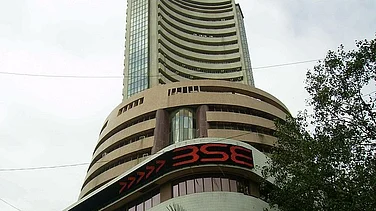Even as global financial markets were caught in intense selling pressure since Trump’s April 2 tariff announcement, India emerged as the sole bright spot. While the domestic benchmarks, the Sensex and Nifty 50 were also caught in the fire initially, the two headline indices managed to not just defy the global downturn, but also recovered losses to jump back into the green since April 2.
The Sensex and Nifty rose by 2.5% and 2.2%, respectively, in local currency terms, and by over 2% in US dollar terms since April 2, according to Bloomberg data. With this, the two benchmarks have emerged as standouts as compared to other global indices that clocked in steep cuts.
Charging on with that momentum, the Nifty surged over 4% this week, and climbed 6.5% over the past five sessions, the strongest among major global indices. In comparison, the Shanghai Composite rose 2%, Japan’s Nikkei gained 1.3%, and the S&P 500 fell 1.4%.
Among 16 key global markets, India remains the only large economy where equities have not only recovered from post-announcement losses but surged beyond pre-tariff levels.
Global equities have remained under pressure since Donald Trump delivered on his plans for reciprocal tariffs on April 2. Wall Street indices-the S&P 500 and Dow Jones have lost 7% and 6%, respectively, while Europe’s key indices have also taken a hit as France’s CAC 40 has fallen 7.5%, Germany’s DAX 5.4%, and the UK’s FTSE 100 by 3.9%.
Asian markets have fared no better. China’s CSI 300 is down 3.9%, Hong Kong’s Hang Seng has dropped 7.8%, and Taiwan’s benchmark index has declined 8.4%. Japan’s Nikkei is down 3.8% in local terms, South Korea’s Kospi has fallen 1.4%, and other regional indices such as Jakarta (-1.7%), the Philippines (-1.8%), and New Zealand’s NZX 50 (-2.1%) have also posted negative returns. Brazil’s Ibovespa is down 2.2%.
India’s outperformance is driven by multiple tailwinds that support its growth story. The government has acted swiftly to ease trade tensions by cutting tariffs on select US imports — high-end motorcycles (from 50% to 30%), bourbon whiskey (150% to 100%), and telecom equipment (20% to 10%).
Analysts at Antique Stock Broking also believe the direct impact on India is limited, as the higher tariffs primarily target competing countries. :Moreover, India’s exports to the US largely consist of low value-added products, and overall exports to the US account for only around 2% of the country’s GDP,” the brokerage said.
Additionally, falling crude oil prices have helped reduce inflationary pressure and improve the trade deficit. Topping that up are signs of recovery on the domestic front.
Even before the tariff announcements, UBS Securities noted that India’s cyclical recovery appeared to be gaining momentum as several of 2024’s economic headwinds began to ease. “These included a sharp turnaround in central government capital expenditure, going from a 35% year-on-year decline in the first half to a 26% increase in the second half (October–February) alongside proactive liquidity support, regulatory easing, and interest rate cuts,” UBS wrote.
Meanwhile, the global firm also expects lower global oil prices and the offloading of excess Chinese capacity into India at reduced rates to help moderate inflation, with UBS projecting it at 4% year-on-year for FY26.
Now if Trump’s reciprocal tariffs do make it to reality, it will have far reaching negative implications. These steeper-than-expected tariffs, if sustained, with drag global growth by sparking a 7.5% erosion of global trade volumes. While India is unlikely to remain immune to a global slowdown, UBS Securities, like many others, believes it is less at risk than Asia's more open economies.
“Compared with its regional peers, India is less exposed to global trade on the goods side and its services exports (currently around 47% of total exports) could provide a buffer against global trade disruptions,” it wrote.






























